Abstract
Forty commercial saturation divers, mean age 34.9 (range 24-49) years, were examined one to seven years after their last deep dive (190-500 metres of seawater). Four had by then lost their divers' licence because of neurological problems. Twenty seven (68%) had been selected by neurological examination and electroencephalography before the deep dives. The control group consisted of 100 men, mean age 34.0 (range 22-48) years. The divers reported significantly more symptoms from the nervous system. Concentration difficulties and paraesthesia in feet and hands were common. They had more abnormal neurological findings by neurological examination compatible with dysfunction in the lumbar spinal cord or roots. They also had a larger proportion of abnormal electroencephalograms than the controls. The neurological symptoms and findings were highly significantly correlated with exposure to deep diving (depth included), but even more significantly correlated to air and saturation diving and prevalence of decompression sickness. Visual evoked potentials, brainstem auditory evoked potentials, and magnetic resonance imaging of the brain did not show more abnormal findings in the divers. Four (10%) divers had had episodes of cerebral dysfunction during or after the dives; two had had seizures, one had had transitory cerebral ischaemia and one had had transitory global amnesia. It is concluded that deep diving may have a long term effect on the nervous system of the divers.
Full text
PDF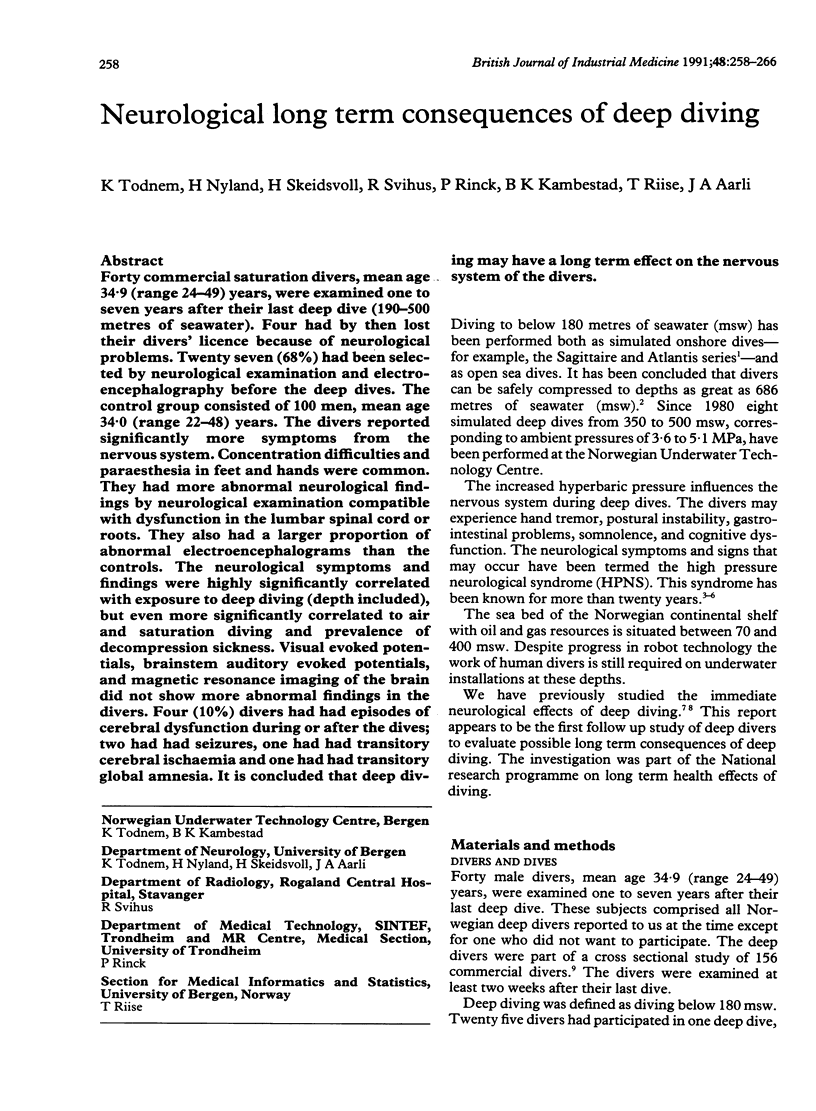
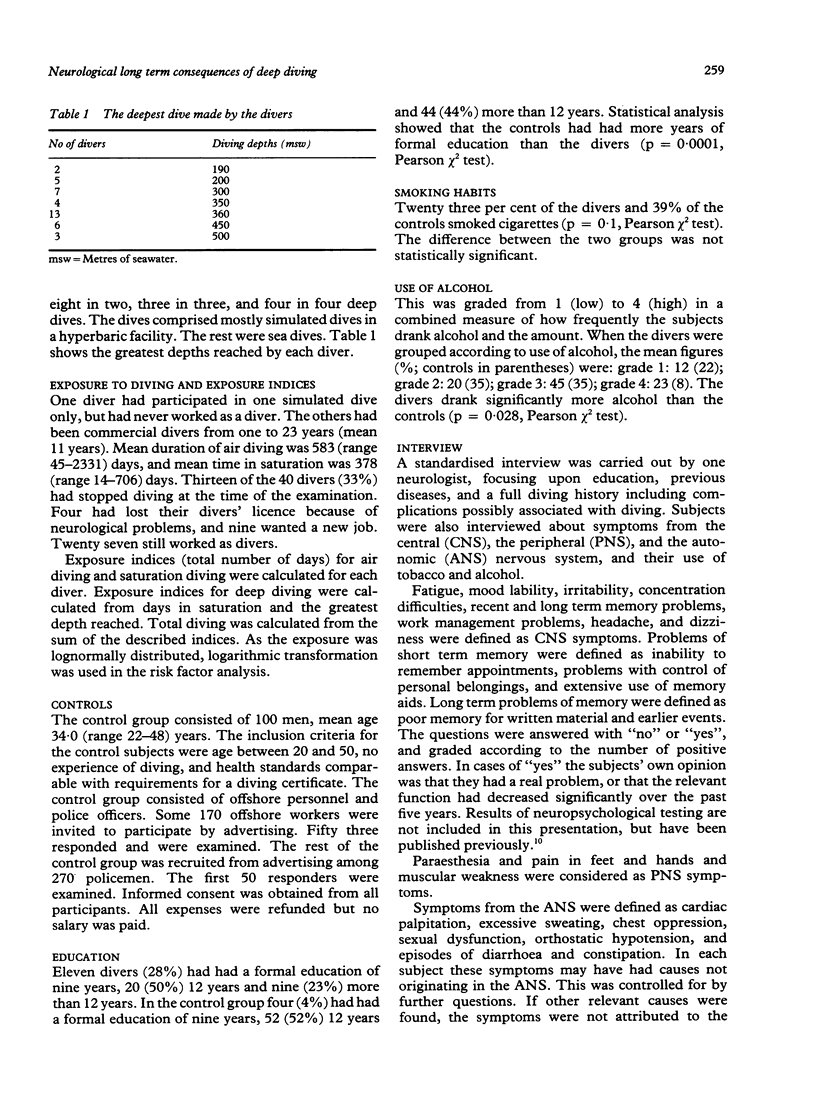
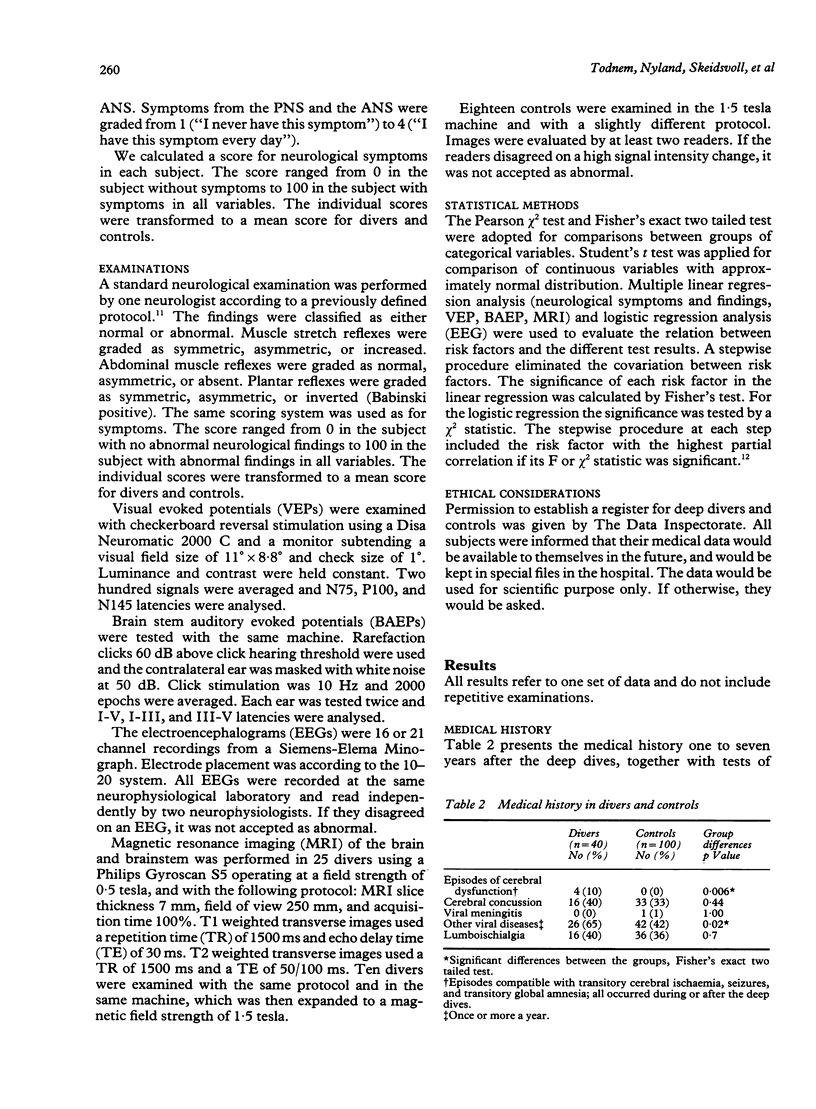
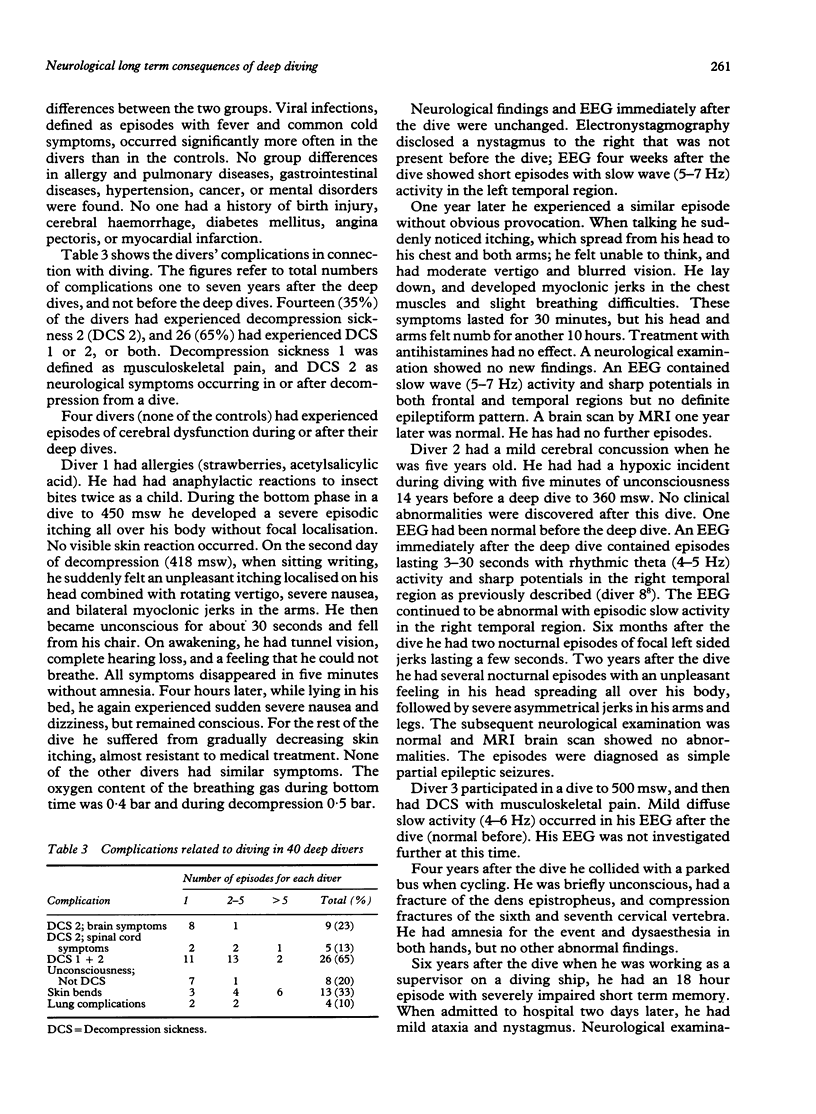
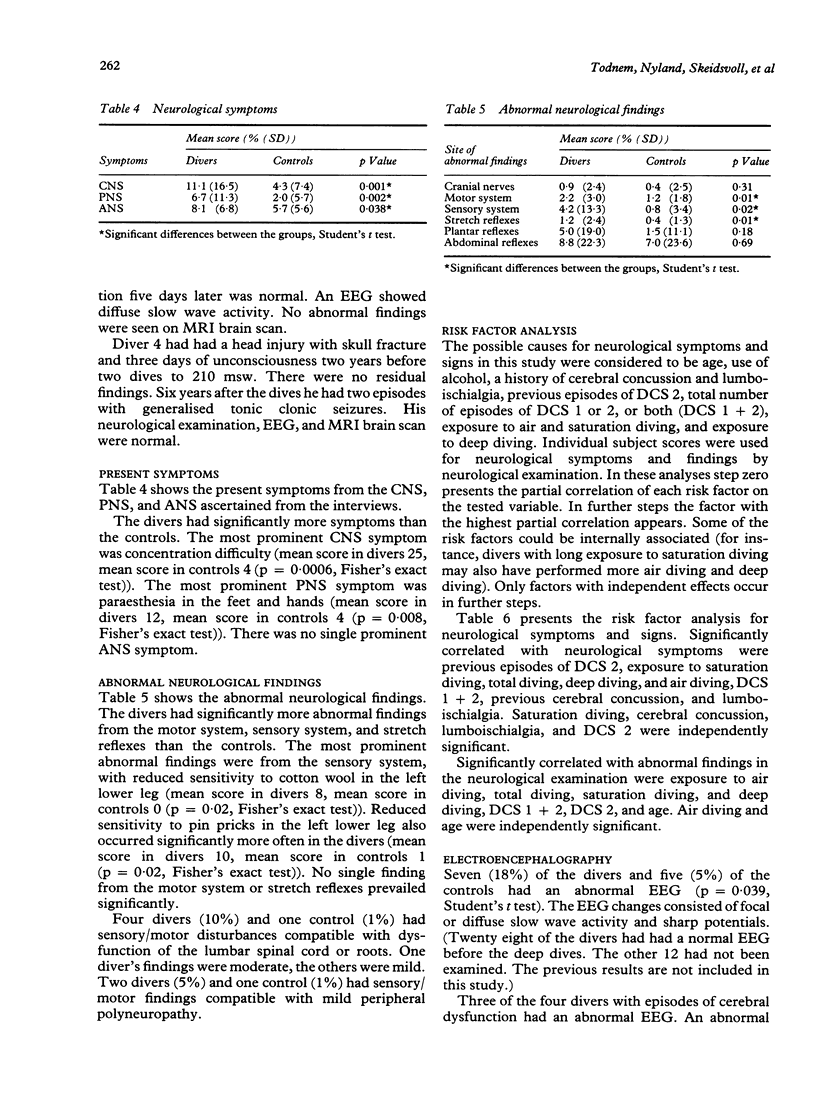
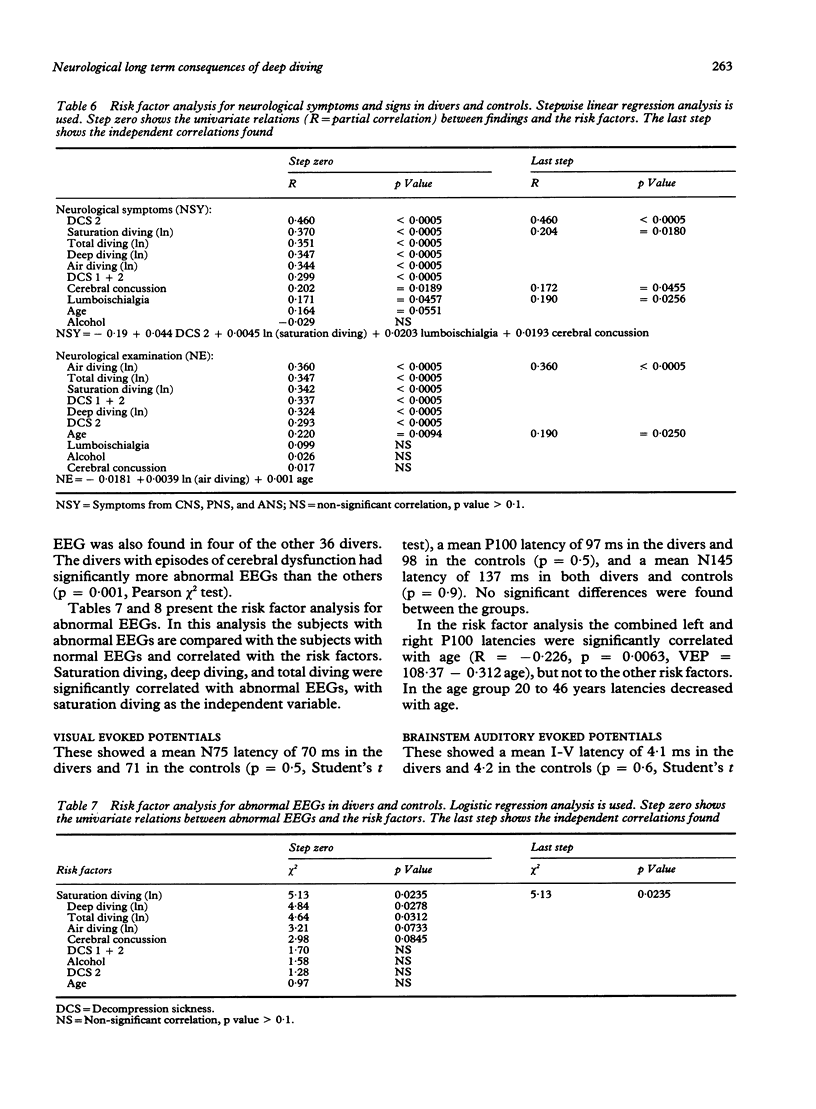
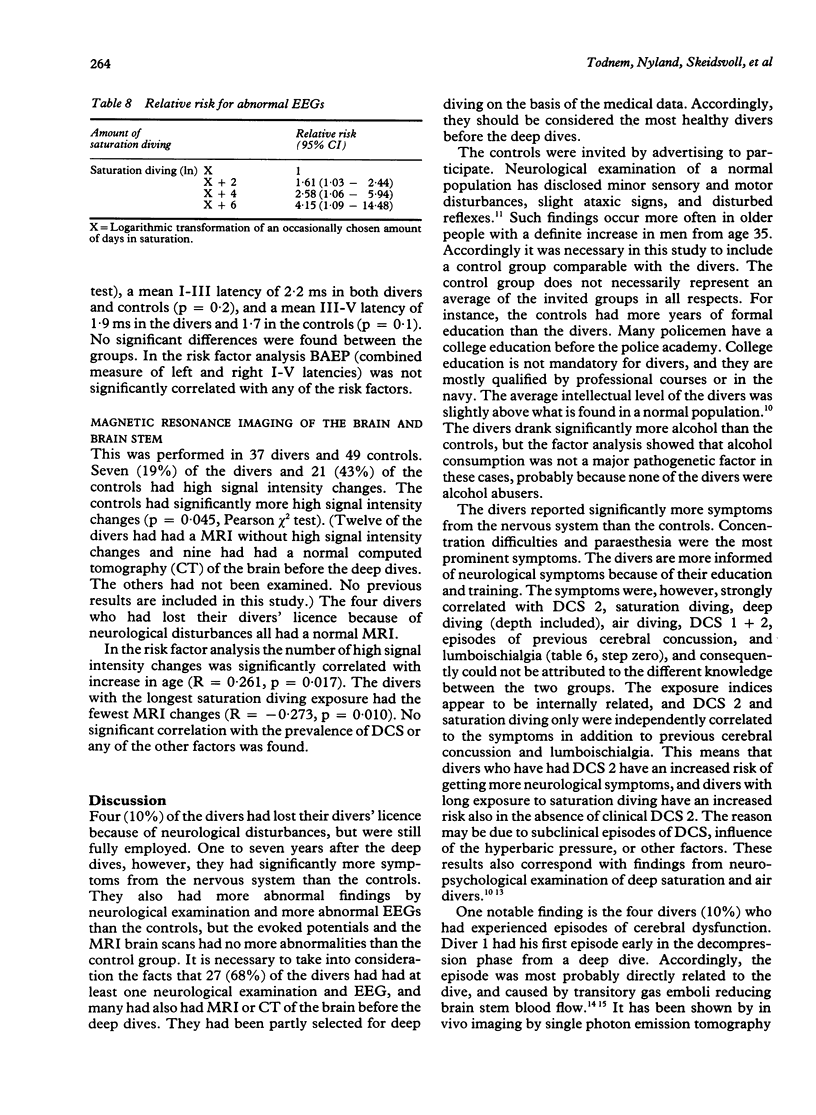
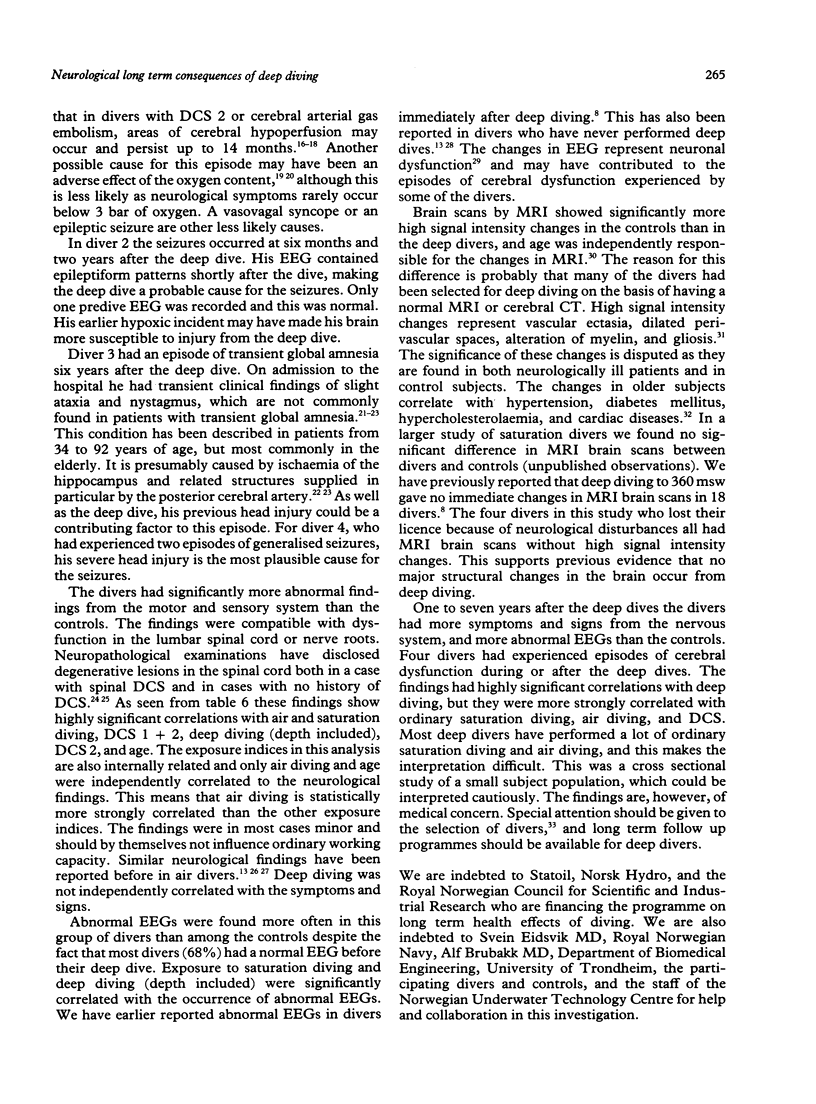
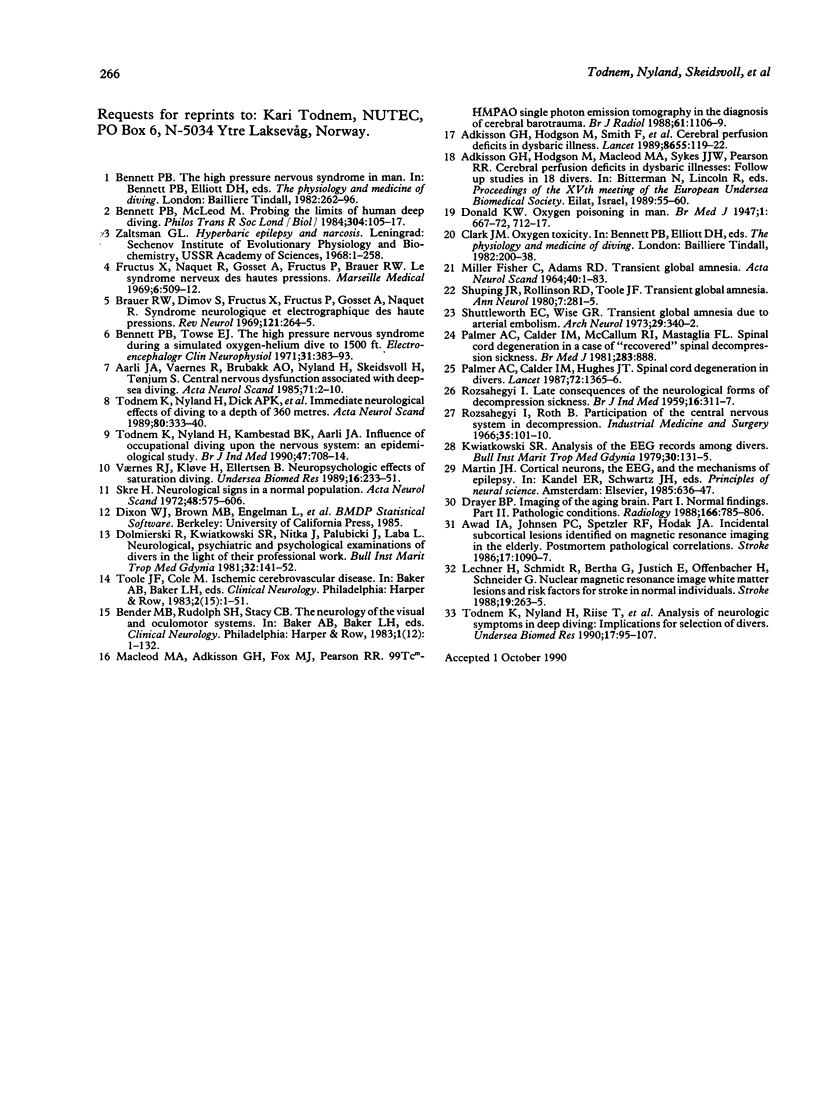
Selected References
These references are in PubMed. This may not be the complete list of references from this article.
- Aarli J. A., Vaernes R., Brubakk A. O., Nyland H., Skeidsvoll H., Tønjum S. Central nervous dysfunction associated with deep-sea diving. Acta Neurol Scand. 1985 Jan;71(1):2–10. doi: 10.1111/j.1600-0404.1985.tb03159.x. [DOI] [PubMed] [Google Scholar]
- Adkisson G. H., Macleod M. A., Hodgson M., Sykes J. J., Smith F., Strack C., Torok Z., Pearson R. R. Cerebral perfusion deficits in dysbaric illness. Lancet. 1989 Jul 15;2(8655):119–122. doi: 10.1016/s0140-6736(89)90180-3. [DOI] [PubMed] [Google Scholar]
- Awad I. A., Johnson P. C., Spetzler R. F., Hodak J. A. Incidental subcortical lesions identified on magnetic resonance imaging in the elderly. II. Postmortem pathological correlations. Stroke. 1986 Nov-Dec;17(6):1090–1097. doi: 10.1161/01.str.17.6.1090. [DOI] [PubMed] [Google Scholar]
- Bennett P. B., McLeod M. Probing the limits of human deep diving. Philos Trans R Soc Lond B Biol Sci. 1984 Jan 7;304(1118):105–117. doi: 10.1098/rstb.1984.0013. [DOI] [PubMed] [Google Scholar]
- Bennett P. B., Towse E. J. The high pressure nervous syndrome during a simulated oxygen-helium dive to 1500 ft. Electroencephalogr Clin Neurophysiol. 1971 Oct;31(4):383–393. doi: 10.1016/0013-4694(71)90234-3. [DOI] [PubMed] [Google Scholar]
- Brauer R. W., Dimov S., Fructus X., Fructus P., Gosset A., Naquet R. Syndrome neurologique et électrographique des hautes pressions. Rev Neurol (Paris) 1969 Sep;121(3):264–265. [PubMed] [Google Scholar]
- DONALD K. W. Oxygen poisoning in man. Br Med J. 1947 May 17;1(4506):667–passim. [PMC free article] [PubMed] [Google Scholar]
- Drayer B. P. Imaging of the aging brain. Part II. Pathologic conditions. Radiology. 1988 Mar;166(3):797–806. doi: 10.1148/radiology.166.3.3277248. [DOI] [PubMed] [Google Scholar]
- Fructus X., Naquet R., Gosset A., Fructus P., Brauer R. W. Le syndrome nerveux des hautes pressions. Mars Med. 1969;106(6):509–512. [PubMed] [Google Scholar]
- Kwiatkowski S. R. Analysis of the EEG records among divers. Bull Inst Marit Trop Med Gdynia. 1979;30(2):131–135. [PubMed] [Google Scholar]
- Lechner H., Schmidt R., Bertha G., Justich E., Offenbacher H., Schneider G. Nuclear magnetic resonance image white matter lesions and risk factors for stroke in normal individuals. Stroke. 1988 Feb;19(2):263–265. doi: 10.1161/01.str.19.2.263. [DOI] [PubMed] [Google Scholar]
- Macleod M. A., Adkisson G. H., Fox M. J., Pearson R. R. 99Tcm-HMPAO single photon emission tomography in the diagnosis of cerebral barotrauma. Br J Radiol. 1988 Dec;61(732):1106–1109. doi: 10.1259/0007-1285-61-732-1106. [DOI] [PubMed] [Google Scholar]
- Palmer A. C., Calder I. M., Hughes J. T. Spinal cord degeneration in divers. Lancet. 1987 Dec 12;2(8572):1365–1366. doi: 10.1016/s0140-6736(87)91259-1. [DOI] [PubMed] [Google Scholar]
- Palmer A. C., Calder I. M., McCallum R. I., Mastaglia F. L. Spinal cord degeneration in a case of "recovered" spinal decompression sickness. Br Med J (Clin Res Ed) 1981 Oct 3;283(6296):888–888. doi: 10.1136/bmj.283.6296.888. [DOI] [PMC free article] [PubMed] [Google Scholar]
- ROZSAHEGYI I. Late consequences of the neurological forms of decompression sickness. Br J Ind Med. 1959 Oct;16:311–317. doi: 10.1136/oem.16.4.311. [DOI] [PMC free article] [PubMed] [Google Scholar]
- Rozsahegyi I., Roth B. Participation of the central nervous system in decompression. Ind Med Surg. 1966 Feb;35(2):101–110. [PubMed] [Google Scholar]
- Shuping J. R., Rollinson R. D., Toole J. F. Transient global amnesia. Ann Neurol. 1980 Mar;7(3):281–285. doi: 10.1002/ana.410070313. [DOI] [PubMed] [Google Scholar]
- Shuttleworth E. C., Wise G. R. Transient global amnesia due to arterial embolism. Arch Neurol. 1973 Nov;29(5):340–342. doi: 10.1001/archneur.1973.00490290080011. [DOI] [PubMed] [Google Scholar]
- Skre H. Neurological signs in a normal population. Acta Neurol Scand. 1972;48(5):575–606. doi: 10.1111/j.1600-0404.1972.tb07577.x. [DOI] [PubMed] [Google Scholar]
- Todnem K., Nyland H., Dick A. P., Lind O., Svihus R., Molvaer O. I., Aarli J. A. Immediate neurological effects of diving to a depth of 360 metres. Acta Neurol Scand. 1989 Oct;80(4):333–340. doi: 10.1111/j.1600-0404.1989.tb03889.x. [DOI] [PubMed] [Google Scholar]
- Todnem K., Nyland H., Kambestad B. K., Aarli J. A. Influence of occupational diving upon the nervous system: an epidemiological study. Br J Ind Med. 1990 Oct;47(10):708–714. doi: 10.1136/oem.47.10.708. [DOI] [PMC free article] [PubMed] [Google Scholar]
- Todnem K., Nyland H., Riise T., Kambestad B. K., Vaernes R., Hjelle J. O., Svihus R., Aarli J. A. Analysis of neurologic symptoms in deep diving: implications for selection of divers. Undersea Biomed Res. 1990 Mar;17(2):95–107. [PubMed] [Google Scholar]
- Vaernes R. J., Kløve H., Ellertsen B. Neuropsychologic effects of saturation diving. Undersea Biomed Res. 1989 May;16(3):233–251. [PubMed] [Google Scholar]


